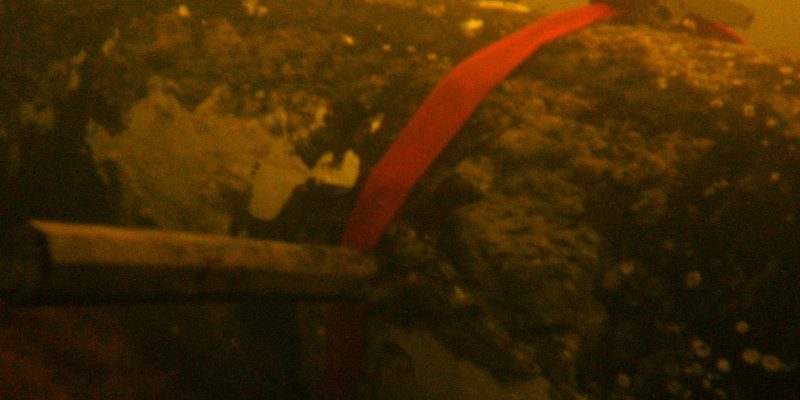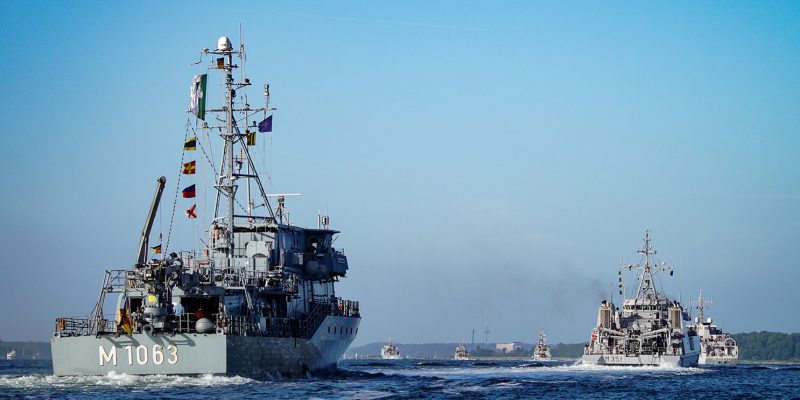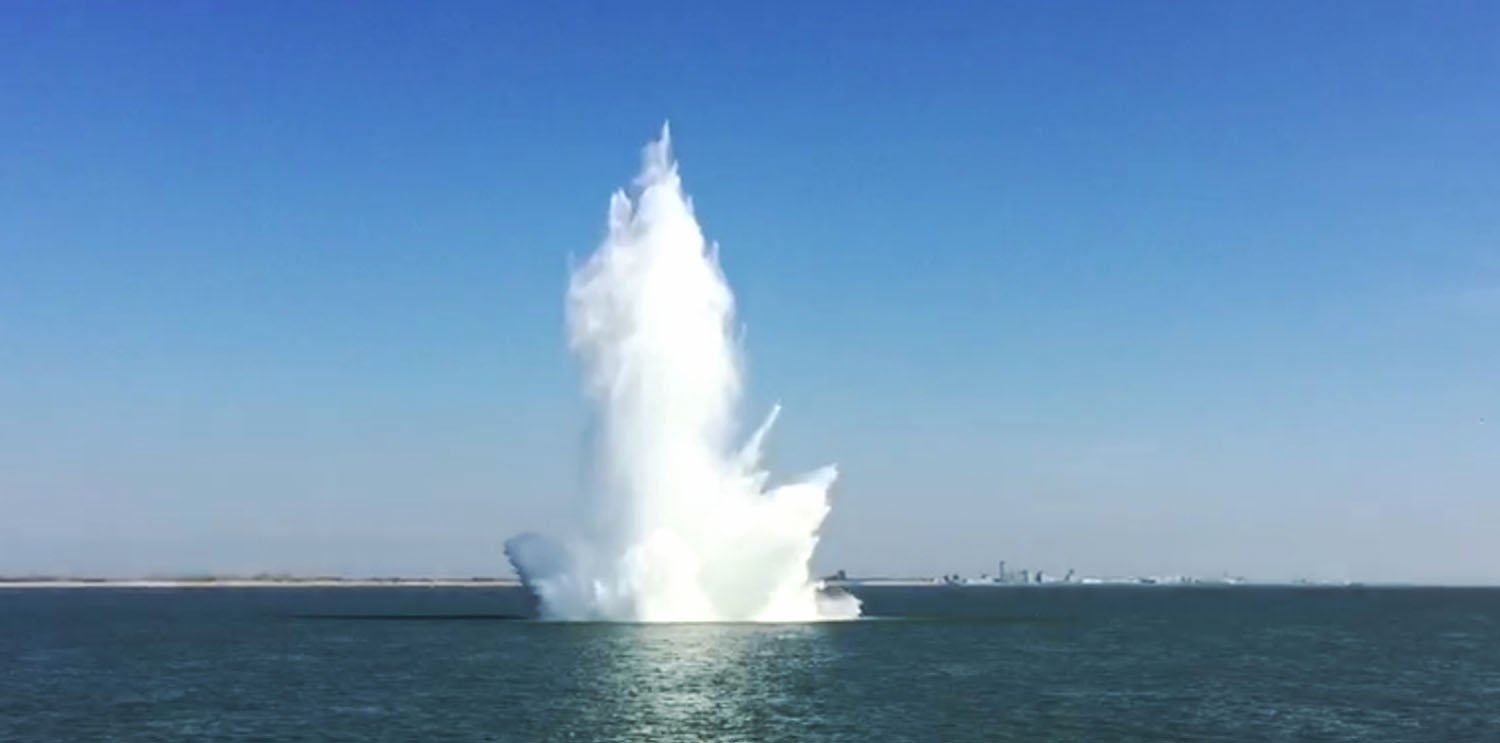Since the end of the Second World War, millions of tonnes of contaminated waste have been stored in German waters. Their removal is still the subject of controversial debate between the federal and state governments.
In the twelve-mile zone of the North Sea and Baltic Sea and in the seaward Exclusive Economic Zone (EEZ), there are around 1.6 million tonnes of old munitions, including over 5,000 tonnes of gas munitions. The nautical charts show 15 dumping areas, labelled as "unclean munitions" or "anchoring and fishing prohibited". There are also positions with scattered munitions. The inventory has not yet been finalised. Since 2011, the Federal/State Working Group on the North Sea and Baltic Sea (Blano) has published the annually updated report "Munitions contamination of German marine waters". Unfortunately, the associated maps have not been updated since 2011.
Federal research and development programmes for environmental monitoring, the health of fish and the development of a robotic system to render underwater munitions harmless are underway for risk assessment and salvage. The University of the Federal Armed Forces in Munich is working on the control of unmanned underwater vehicles for detection. In addition, international organisations such as the EU, Helcom and the Conference of Baltic Sea Parliamentarians are taking care of the contaminated sites. The EU is funding the Basta programme for munitions detection, including artificial intelligence.
In contrast to the post-war period, serious accidents at sea or on the beach are very rare today. The main concern at present is therefore the impact on the ecosystem caused by leaking substances such as TNT and phosphorus, as the explosive ordnance rusts and decomposes. Private companies, fishermen, authorities and the navy have rendered a lot of material harmless since the end of the war, for example for the 1972 sailing Olympics off Kiel. Despite this, there is still a lot to be done in view of the remaining total quantity.
The procedure is to act according to a specific risk assessment, i.e. not to salvage in designated dumping areas, but to secure transport routes. There is also agreement on the hazards associated with work and utilisation on the seabed, for example wind turbines, power lines, pipelines, coastal structures, tunnelling, sand and gravel extraction, bottom and trawl fishing and diving.
In principle, there are three options to choose from. Firstly, leave it lying around, monitor it and, if necessary, restrict its use. Secondly, salvage and dispose of. Thirdly, detonate if the critical condition does not permit salvage. The 2017 coalition agreement in Kiel also mentions the goals of an ammunition register, the collation of evaluation results and the promotion of technologies. The coastal states, all parties and many experts are tirelessly in favour of comprehensive clearance. The German government recognises that environmentally friendly and cost-effective methods still need to be developed.
This raises the question of responsibilities. The aforementioned Blano working group has existed for a long time. In 2019, the Conference of Interior Ministers decided to initiate the Explosive Ordnance Clearance Working Group. Contrary to what the name might suggest, the focus is not on clearance, but on the exchange of information, technical coordination and a digital cadastre. The Conference of Environment Ministers has issued test orders for the procurement of information and requested additional funding from the federal government. A reporting centre for all new finds has also been in place at the Central Command for Maritime Emergencies in Cuxhaven since 2013. These structures are useful, but are limited to information, support and coordination. The reasons for this "co-operative approach" lie in the federal system of the federal states and the federal government.
As there is no specific legislation on munitions contamination, the law on general hazard prevention applies in the relationship between the federal government and the federal states. The federal states are responsible for security throughout their territory on land and at sea. The responsibilities of the federal states for the police, including the waterway police, safety and order, explosive ordnance clearance services, disaster control, environmental protection and nature conservation are laid down in the Basic Law. Another reason is the fact that the federal government does not have its "own" territory, as the republic is made up of the federal states. The federal state can deploy its clearance services or award contracts to companies and will do so if the condition of the munitions so requires. Each procedure requires a case-by-case assessment by specialised personnel. Due to the territorial responsibility, the federal states bear the main burden of clearance, especially as the bulk of the contaminated sites are located in coastal waters.

German GC mine from the Second World War
The Federal Government always refers to the lack of general competences in the Basic Law. However, sectoral exceptions apply. The most important area of federal responsibility is "the defence against dangers to the safety and ease of traffic" on the sea waterways in the entire coastal sea, whereby "traffic" refers to shipping traffic. The legal basis is the Maritime Responsibilities Act. Implementation is the responsibility of the federal Waterways and Shipping Administration (WSV). However, this only concerns the safety of the transport route. The normal flow of traffic is protected by the clearance of obstacles. Further details are regulated by the Federal Waterways Act. The federal government will check on a case-by-case basis whether there is a concrete danger to shipping; a latent danger is not sufficient. In addition, the restriction "insofar as it is economically justifiable" applies. Other legal interests are not protected by this law.
The federal government also has a duty when it comes to the safety of shipping in the EEZ, where the smaller proportion of contaminated sites is located. According to Section 1.3 of the Maritime Responsibilities Act, the federal government is responsible for averting dangers and eliminating disruptions to public safety and order limited to shipping routes. Other sea users in the EEZ, such as contractors for wind farms, pipelines or raw material extraction, are themselves responsible for the disposal of munitions there.
There are other federal responsibilities in the Maritime Responsibilities Act that support munitions clearance, such as sea surveys, wreck searches and reporting obligations for finds. In specific cases, the German Armed Forces can provide administrative assistance if they still have specialised personnel, mine detectors, detection and explosive devices. Occasionally, naval manoeuvres can be used when it is necessary to take concrete action on the seabed. The German Armed Forces' basic directive on environmental protection then applies to the navy. According to this, damage must be minimised.
In the event of major incidents or complex damage situations caused by ammunition accidents, the Central Command is responsible for coordinating measures. The federal states or the federal government are liable for specific cases of damage in the event of personal injury or damage to property. A general liability of the states for the consequences of the dumping of ammunition is sometimes advocated, but will hardly be enforceable.
Blasting operations, such as the destruction of 42 British sea mines off Fehmarn in August 2019, may come into conflict with the Federal Nature Conservation Act (BNatSchG). The law prohibits the killing of harbour porpoises and there is a general obligation to participate. The legal situation regarding blasting was the subject of responses to minor interpellations and a report by the Bundestag's scientific services in 2020. According to this, shipping and military exercises are generally permitted in areas protected under nature conservation law. However, there is an obligation to provide information and participate if nature conservation concerns are affected, as is the case with blasting. The obligation to participate means that the nature conservation authorities must be informed in advance and given the opportunity to comment within a reasonable period of time. No "agreement" is required, only participation in the literal sense. This involves impact assessments, the use of mitigation measures or the postponement of deadlines. In cases of urgency and danger to life and limb, short participation periods are possible. In legal terms, it boils down to weighing up the protection of life (of seafarers) and ships against nature conservation. In 2020, the Federal Ministries of the Environment and Defence agreed on a joint approach to blasting. The navy reportedly wants to do without blasting, which could lead to a further loss of capability.

Minesweepers from various nations on their way to the deployment area
With regard to the distribution of costs for munitions clearance, the principle of connectivity in Article 104a of the Basic Law generally applies. According to this, the burden of expenditure follows the burden of responsibility. Just as the federal states finance their police and educational institutions, they are also responsible for munitions clearance. At this point, Article 120 of the Basic Law "Occupation costs and post-war burdens" also comes into play. According to this article, the federal government " ...the expenses for occupation costs and other internal and external consequential war costs as specified by federal law". Such a federal law, which the federal states have been endeavouring to pass since 1992, does not yet exist. In the current legislative period, the Bundesrat is still working on a draft "Armaments Legacy Financing Act" (RüstAltFG). It provides for the transfer of costs to the federal government. However, the federal government has rejected these proposals for decades and refers to the responsibility of the federal states for hazard prevention, the principle of connectivity and the measures that the federal government supports financially to relieve the burden on the federal states. In particular, it emphasises the "state practice" of actual cost sharing established since the 1950s in the context of Article 120 of the Basic Law. The Federal Government distinguishes between "Reich-owned" and "Allied munitions" - a differentiation that the federal states regard as unrealistic. The federal government provides 30 million euros annually in the form of reimbursements to the federal states for the disposal of Reich-owned munitions in cases of immediate danger. For the salvage and destruction of allied munitions, it grants a voluntary reimbursement of 50 per cent of the costs. The federal states certainly recognise these benefits, but criticise the fact that they only help in individual cases and cannot solve the mega problem at sea.
To summarise: The federal legal situation assigns the central tasks of contaminated sites to the coastal states. The federal government limits itself to sectoral responsibilities. It voluntarily offers to reimburse costs in individual cases. It supports research and technology development and can provide administrative assistance with its authorities and the Federal Armed Forces. It is theoretically possible to amend the Basic Law with the aim of increasing federal responsibilities. The example of unsuccessful efforts over seventy years to establish a unified German coastguard, combining federal and state tasks at sea, shows that there is a widespread lack of support from parliaments, ministries and public opinion when it comes to shifting tasks and costs. Here, too, the enormous financial requirements for large-scale salvage, transport and processing are the main obstacle. Hopes are pinned on potentially more cost-effective delaboration on platforms at sea. In the short term, therefore, the only remaining options are the documentation of finds, bans in critical areas, the reinforcement of the clearance services of the federal states and the utilisation of the administrative assistance of the neglected naval mine detection forces, which must be rebuilt not only for this purpose.
The article is an updated abridged version of the publication "Rechtslage zur Munitionsräumung auf See - Zuständigkeiten, Maßnahmen, Kostenregelung" in the Zeitschrift für öffentliches Recht in Norddeutschland (NordÖR), No. 11/2020.
Prof Dr Uwe Jenisch teaches at the Walther Schücking Institute for International Law at Kiel University.
Photos: , Koninklijke Marine, Author's archive, Bundeswehr/Marcus Mohr












Question: who dumped the munitions in the North and Baltic Seas? Germany???? No!!!! the Allies at the time? Yes!!! Did they contribute to the removal and the costs? No!!! Where is the mistake?